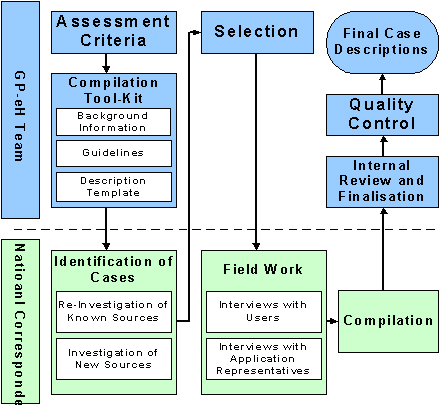
Here are the instructions how to enable JavaScript in your web browser

The diagram below outlines the process of identification, selection, and compilation of good practice cases.

A Good eHealth internal selection board reviews all the cases and agrees by majority vote on a final list of cases to be further investigated. The selection board consists of members of the project consortium. The number of proposed cases must be considerably higher than the number that will actually enter the knowledge base: We found that this ratio is about 6:1. Essentially, this ratio provides a quality criterion for the end product – the eHealth Good Practice knowledge base
Based on their expert knowledge, the internal selection board excludes cases guided by these 12 criteria:
Via a network of country correspondents the project has access to a large amount of known eHealth applications. Thus some good practice cases may be published in this project database for the first time. They may be unknown previously outside their own national, regional, or local setting. They may be written about only in their country’s national language. Here is their chance to reach the daylight.
Outlining the background
The case identification process is based on three pillars:
The project team continously observes the eHealth market which means that it will have screened about 600 eHealth solutions by the end of the project.
Identifying a case
Templates are vital tools in helping to sculpt the case identification and description process. A case is "identified" when a case owner has filled in and submitted the identification template. The template is designed to provide the minimum amount of information needed for the selection of a good practice case.
Describing a case
A selected case is investigated in further depth. Secondary source material from and telephone interviews with stakeholders are used.
Country correspondents are used in this process. The are native speakers of the case's country and can communicate most effectively with the case owner. The country correspondent deliver their output back to the project team for which assesses the case’s quality.